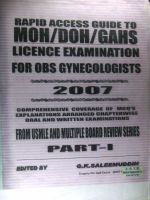1. To plan an effective revision program.
2. There are certain basic principles which are relevant to Examination
3. Read relevant literature. And form an alliance with other candidates by meeting on a regular basis with good teaching notes need to read around the topic.
4. On Examination day: Arrive in time.
5. By ai. iving in time you have the chance to prepare mentally for the examination. When you sit down to start working on the papers you will already be in the right frame of mind and this will save your valuable time.
Contents
Femare Reproductive Tract. 1
Functional anatomy of the female reproductive tract. 1
Functional histology of the female reproductive tract. 8
Development of the embryo, fetus, and placenta. 13
Physiologic changes of pregnancy. 16
Review Test. 30
Pregnancy: Prenatal Care and Assessment. 35
Prenatal care. 35
Antepartum fetal assessment. 44
Prenatal diagnosis. 50
Discrepant fundal size. 59
Postdates pregnancy. 62
Review Test. 67
Pregnancy: Obstetric Complications. 73
First-trimester loss. 73
Second-trimester loss. 79
Third-trimester bleeding. 83
Fetal demise. 89
Multiple gestation. 93
Isoimmunization. 99
Gestational trophoblastic neoplasia (GTN). 105
Review Test. 109
Pregnancy: Medical Complications. 113
Hypertensive disorders. 113
Cardiac disease. 119
Thromboembolic disease. 122
Obstetric shock. 124
Pulmonary disorders. 126
Thyroid disorders. 128
Liver disease. 130
Glucose intolerance. 132
Anemia. 138
Urinary tract infections (UTIs). 144
Dermatoses of pregnancy. 146
Review Test. 148
Pregnancy: Perinatal Infectious Diseases. 153
Perinatal infections. 153
Toxoplasmosis. 153
Rubella (German measles) infection. 155
Cytomegalovirus (CMV) infection. 157
Herpes simplex virus (HSV) infection. 158
Syphilis. 160
Hepatitis В virus (HBV) infection. 162
Human immunodeficiency virus (HIV) infection. 164
Group В JJ-hemolytic streptococcus (GBBS) infection. 168
Review Test. 170
Labor and Delivery 173
Normal labor and delivery. 173
Abnormal labor. 178
Intrapartum fetal monitoring. 183
Premature rupture of membranes (PROM). 189
Preterm labor and delivery. 193
Operative delivery. 196
Review Test. 201
The Puerperium. 205
Normal puerperium. 205
Postpartum hemorrhage (PPH). 211
Puerperal infection. 218
Review Test. 224
Common Gynecologic Complaints 227
Gynecologic history. 227
The gynecologic examination. 228
Abnormal Papanicolaou (PAP) smear. 231
Vaginal discharge. 238
Vulvar lesions. 241
Pelvic relaxation. 245
Urinary incontinence. 246
Review Test. 252
Sexually Transmitted Diseases. 255
Sexually transmitted diseases (STDs) with genital ulcers. 255
Sexually transmitted diseases (STDs) without genital ulcers. 258
Review Test. 264
Fertility Control. 267
Contraception. 267
Sterilization. 275
Induced abortion. 279
Review Test. 284
Menstrual and Endocrine Disorders. 287
Precocious puberty. 287
Amenorrhea. 291
Dysmenorrhea. 298
Abnormal menstrual bleeding. 302
Premenstrual syndrome. 306
Hirsutism. 308
Review Test. 313
Menopause. 317
Overview. 317
Postmenopausal bleeding. 323
Review Test. 329
Pelvic Masses and Pelvic Pain. 333
Premenopausal pelvic mass. 333
Postmenopausal pelvic mass. 338
Enlarged uterus. 342
Pelvic inflammatory disease (PID). 347
Ectopic pregnancy. 351
Review Test. 355
14. Sexuality. 359
Introduction. 359
Normal female sexual response. 359
Classification of sexual problems. 363
Clinical approach to sexual problems. 366
Sexual assault. 367
Review Test. 371
15. The Female Breast. 375
Normal breast development. 375
Normal lactation. 377
Breast masses. 379
Breast cancer. 383
Review Test. 389
16 Infertility. 393
Terminology. 393
Requirements for normal fertility. 393
Causes of infertility. 393
Diagnostic evaluation. 397
Management. 398
Endometriosis. 400
Review Test. 401
Comprehensive Examination. 403
Abbreviations. 421
Index. 425

